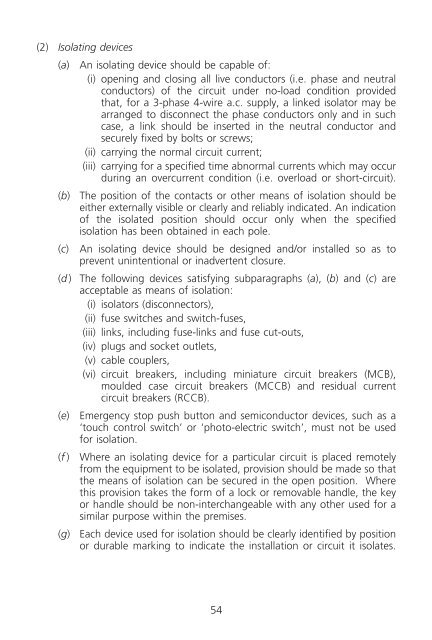Code of Practice for the Electricity (Wiring) Regulations - 2009 Edition
Code of Practice for the Electricity (Wiring) Regulations - 2009 Edition
Code of Practice for the Electricity (Wiring) Regulations - 2009 Edition
You also want an ePaper? Increase the reach of your titles
YUMPU automatically turns print PDFs into web optimized ePapers that Google loves.
(2) Isolating devices<br />
(a) An isolating device should be capable <strong>of</strong>:<br />
(i) opening and closing all live conductors (i.e. phase and neutral<br />
conductors) <strong>of</strong> <strong>the</strong> circuit under no-load condition provided<br />
that, <strong>for</strong> a 3-phase 4-wire a.c. supply, a linked isolator may be<br />
arranged to disconnect <strong>the</strong> phase conductors only and in such<br />
case, a link should be inserted in <strong>the</strong> neutral conductor and<br />
securely fixed by bolts or screws;<br />
(ii) carrying <strong>the</strong> normal circuit current;<br />
(iii) carrying <strong>for</strong> a specified time abnormal currents which may occur<br />
during an overcurrent condition (i.e. overload or short-circuit).<br />
(b) The position <strong>of</strong> <strong>the</strong> contacts or o<strong>the</strong>r means <strong>of</strong> isolation should be<br />
ei<strong>the</strong>r externally visible or clearly and reliably indicated. An indication<br />
<strong>of</strong> <strong>the</strong> isolated position should occur only when <strong>the</strong> specified<br />
isolation has been obtained in each pole.<br />
(c) An isolating device should be designed and/or installed so as to<br />
prevent unintentional or inadvertent closure.<br />
(d ) The following devices satisfying subparagraphs (a), (b) and (c) are<br />
acceptable as means <strong>of</strong> isolation:<br />
(i) isolators (disconnectors),<br />
(ii) fuse switches and switch-fuses,<br />
(iii) links, including fuse-links and fuse cut-outs,<br />
(iv) plugs and socket outlets,<br />
(v) cable couplers,<br />
(vi) circuit breakers, including miniature circuit breakers (MCB),<br />
moulded case circuit breakers (MCCB) and residual current<br />
circuit breakers (RCCB).<br />
(e) Emergency stop push button and semiconductor devices, such as a<br />
‘touch control switch’ or ‘photo-electric switch’, must not be used<br />
<strong>for</strong> isolation.<br />
(f ) Where an isolating device <strong>for</strong> a particular circuit is placed remotely<br />
from <strong>the</strong> equipment to be isolated, provision should be made so that<br />
<strong>the</strong> means <strong>of</strong> isolation can be secured in <strong>the</strong> open position. Where<br />
this provision takes <strong>the</strong> <strong>for</strong>m <strong>of</strong> a lock or removable handle, <strong>the</strong> key<br />
or handle should be non-interchangeable with any o<strong>the</strong>r used <strong>for</strong> a<br />
similar purpose within <strong>the</strong> premises.<br />
(g) Each device used <strong>for</strong> isolation should be clearly identified by position<br />
or durable marking to indicate <strong>the</strong> installation or circuit it isolates.<br />
54














